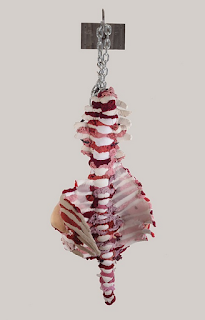Chris Suleski
Professor Cacoilo
Art History II
11/5/19
Feast
and Famine
The
Circumstance Surrounding Food
Divya
Mehra from left to right
Eating
Right for your type 2015/2019
Chocolate Bar
Modernity
at Large - Candy Hearts 2015
Divya Mehra
received her Master of Fine Arts at Columbia University, New York.
Mehra’s artwork often reflects otherness and the empty promise of
diversity. In the above artwork, both the candy bars and the heart-shape color
candy in the glass bowl are imprinted with the phrase "Enjoy
Diversity". "Both works destabilize singular understandings of
the term diversity - the unquestioned use of which can disguise differences in
politics and policies" ("Between US"). Diversity is something
that has to be valued, respected and accepted. Divya's art is a
perceptive representation of how art can undermine our opinions of race and
sexual identity thru aberrations of food. And in this example, Divya's
represents races with the multiple subtle colors of the valentine sweethearts
and their multiple ingredients, using the word "Enjoy" to emphatically state that
we need to understand, dismiss racial discrimination and to make promises that
are not empty.
Tamara
Kostianovsky
What
It Once Was, 2011
A
fascination in Tamara's adolescent, working in a surgeons office, brought forth
in the body of her work carcasses inspired by memories of butchered
meat she saw while growing up in Argentina, representing the consumption of
meats in the United Sates. Tamara "has cannibalized her own clothing in order to recreate the butchered parts, rendering them more visually digestible. She
explains: I used the various fabrics and textures to conjure flesh,
bone gristle and slabs of fat in live-size sculptures of livestock
carcasses" ("Meat Carcasses"). Tamara uses her artwork to reveal brutal in-humane methods of killing animals in the American Slaughterhouses, emphasizing this particular work by introducing a chain to hang the meat. Her message to the global society is to cut back on the quantity of meat that is eaten and to incur improvement in the industry that would eliminate animal cruelty, as well as finding different means of food consumption.
Pieter Claesz - 1636
Still Life with Tazza
Pieter Claesz was a Dutch still life painter. Claesz "painted breakfast pieces, that is, meals of bread, fruits, and nuts. giving life to inanimate objects" (Stokstad 767), showing his skills of transparencies and reflections, eluding to the passing of time and human life. The tilted silver Tazza certainly indicates the prosperity of his clients. Does the painting suggest an interrupted breakfast or a shear waste of food that is uneaten and will be discarded as rubbish? I believe his
portrait reflects the waste of food represented in the art exhibit
"Feast and Famine" and certainly would display well in its context.
Clara Peeters - 1611 ( Stokstad 754)
Still Life with Flowers, Goblet, Dried Fruit, and Pretzels
Clara Peeters was a famous Flemish female artist of the 17th
century, specializing in still lifes. This work was painted in Peeters
later years due to the presence of fruits, nuts, and flowers.
Peeters goal was to make the scene look lifelike, using self-painted portraits
on the goblet. "On, and near the pewter plate are biscuits and sugar
candy. The half-eaten pretzel, like the miniature self-portraits, suggests that
someone has been at this table, contributing to make the illusion represented
in the painting seem real. It is sometimes stated that this still life has an
implicit vanitas theme, with the wine, flowers and self-portraits alluding to
the fragile nature of life" (HEN). Other than representing the class
of wealth, I feel this particular painting introduces a balanced alternative to
eating meat, reducing the killing of animals and reducing the brutal in-humane
treatment of animals, fitting well into the exhibit "Feast and
Famine".
The portraits herein certainly reflect societal and political concerns relating to discrimination, animal brutality, and the shear neglect of wasted food. To ensure that a future will be forthcoming changes need to occur and they need to begin now, or our culture could face a future that could be undesirable for mankind.
The portraits herein certainly reflect societal and political concerns relating to discrimination, animal brutality, and the shear neglect of wasted food. To ensure that a future will be forthcoming changes need to occur and they need to begin now, or our culture could face a future that could be undesirable for mankind.
Works
Cited
“Between Us.” Banff Centre,
https://www.banffcentre.ca/walter-phillips-gallery/between-us.
HEN-Magonza. “Clara Peeters, Still Life with Flowers, Gilt Goblet, Dried Fruits, Sweets, Biscuits, Wine and a Pewter Flagon.” Flickr, Yahoo!, 9 Dec. 2016, https://www.flickr.com/photos/hen-magonza/30691827304/.
“Meat Carcasses Recreated in Fabric by Tamara Kostianovsky.” Designboom, 11 Aug. 2015, https://www.designboom.com/art/meat-carcasses-recreated-in-fabric-by-tamara-kostianovsky/.
“Opening Reception for ‘Feast & Famine.’” Express Newark, https://www.expressnewark.org/events/opening-reception-for-feast-famine/.
Stokstad, Marilyn, and Michael Watt
Cothren. Art History. Sixth ed., II, Pearson, 2018.




No comments:
Post a Comment